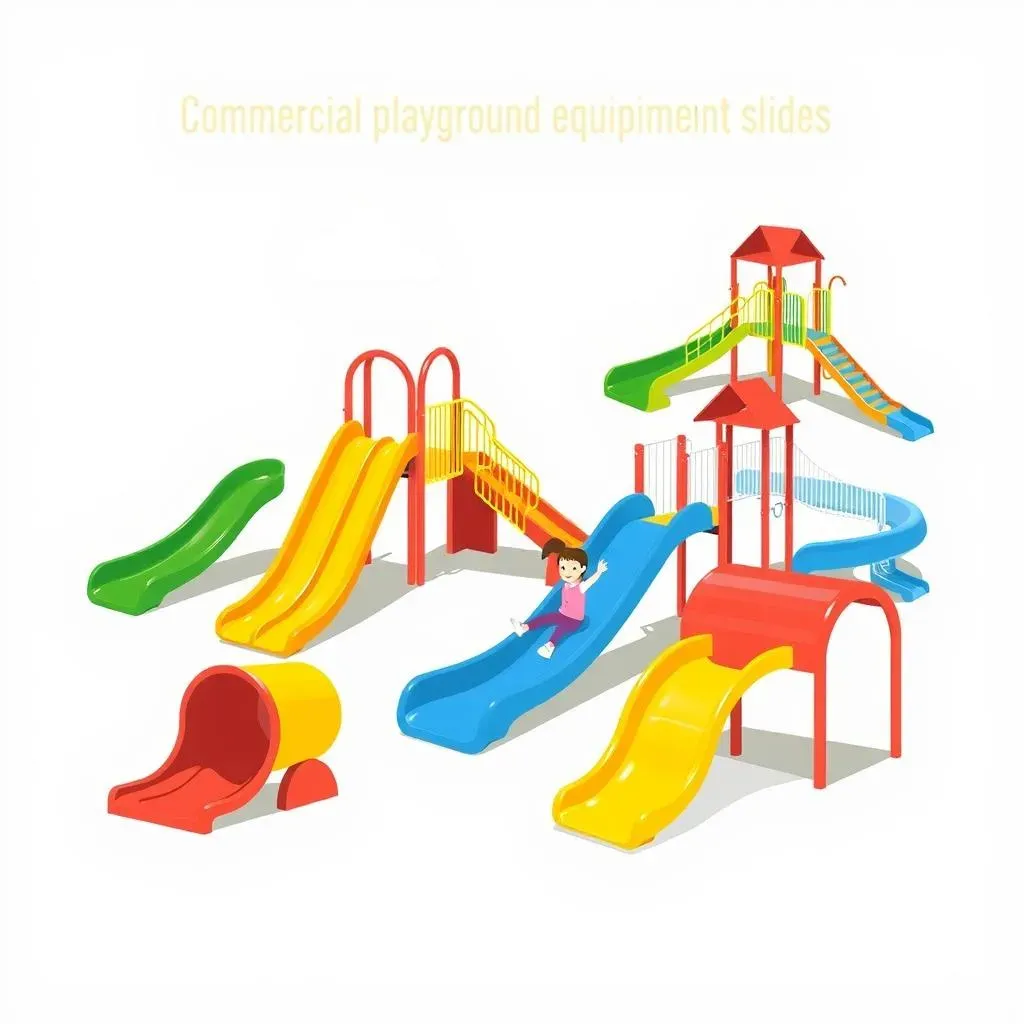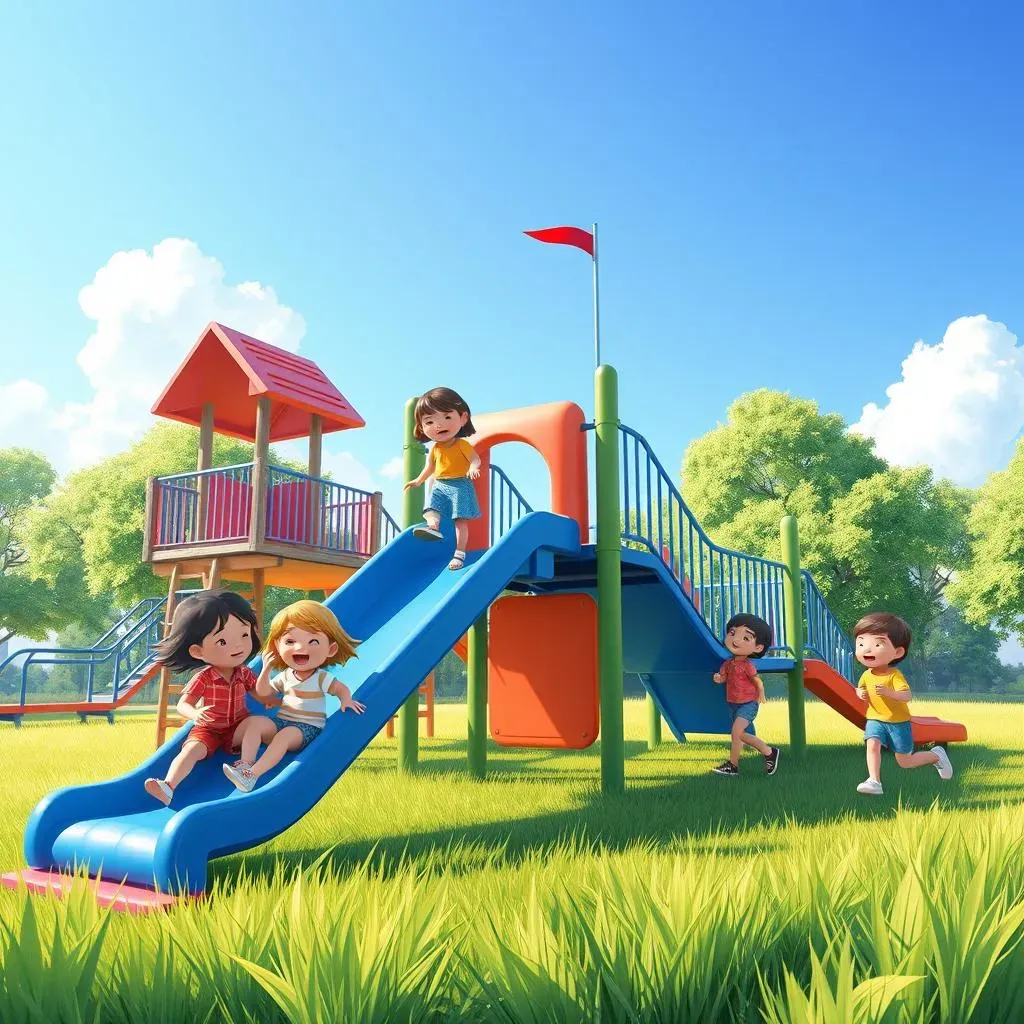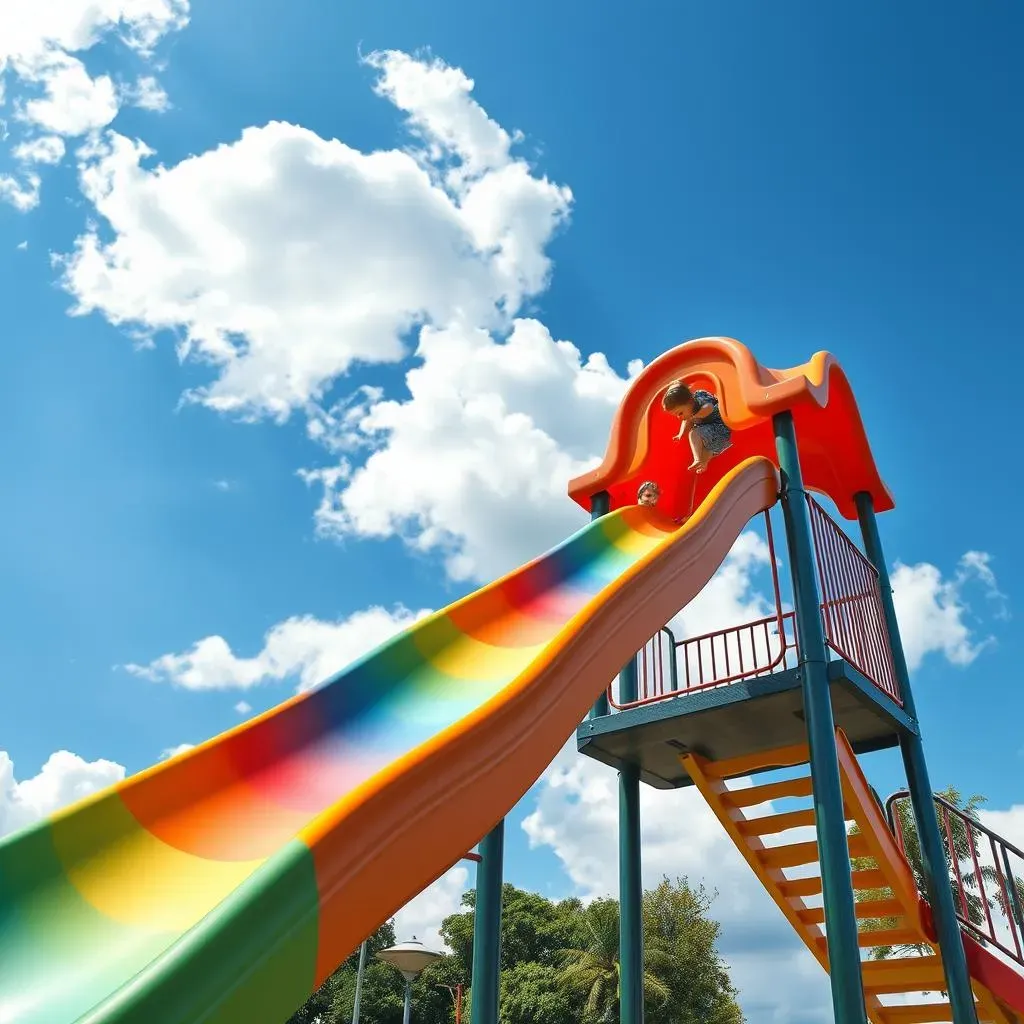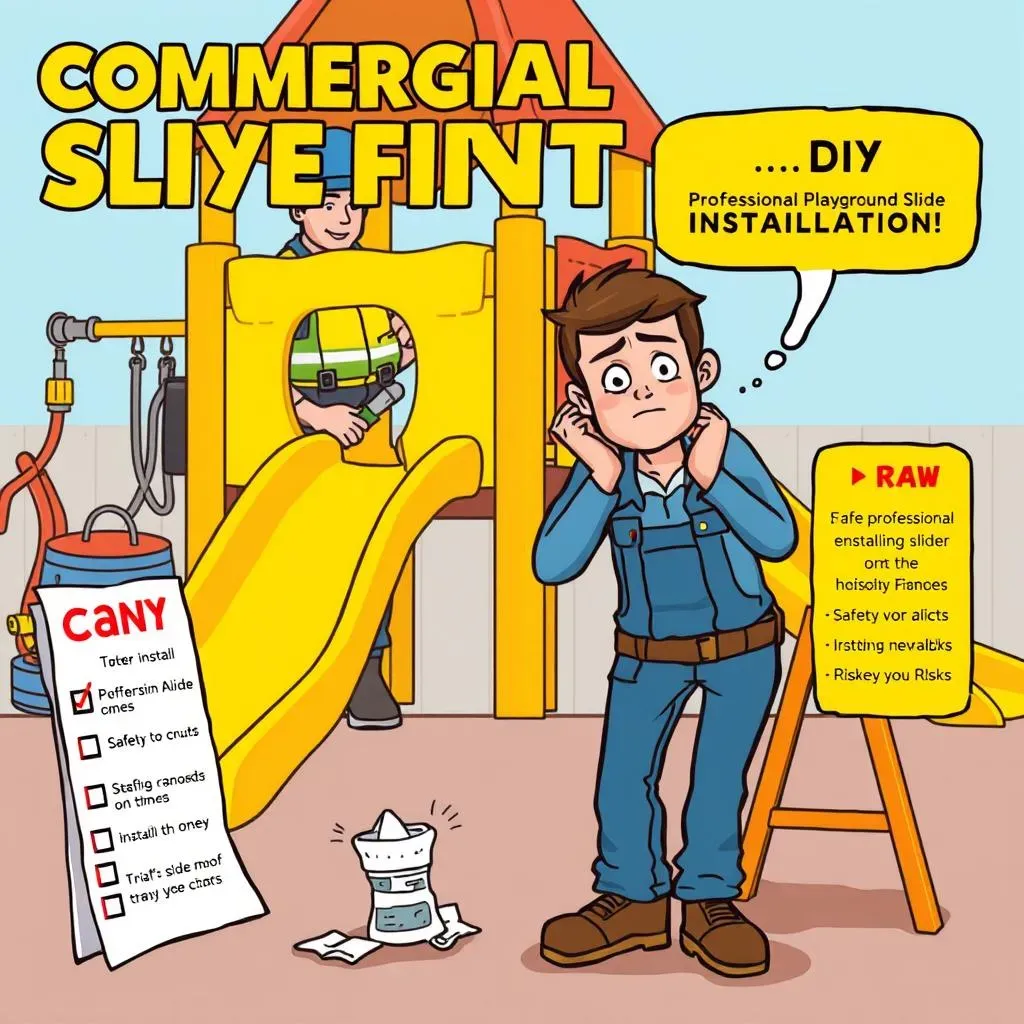Table of Contents
Ever watched kids zoom down a slide, their faces lit up with pure joy? That's the magic of commercial playground equipment slides. They're not just about fun; they're vital for kids' development, encouraging physical activity, social interaction, and even a bit of healthy risk-taking. This article is your go-to guide for all things related to these fantastic play structures. We'll explore the different types of slides, from the classic straight slide to the winding tunnel slide, and what makes each unique. We'll also talk about the benefits these slides bring to a child's growth, both physically and mentally, and the crucial role safety plays in their design and installation. We'll cover the materials used, the construction process, and even how you can customize slides to fit your specific playground needs. So, whether you're a park planner, a school administrator, or just someone who loves watching kids have fun, join us as we slide into the world of commercial playground equipment slides.
Types of Commercial Playground Equipment Slides and Their Features

Types of Commercial Playground Equipment Slides and Their Features
Straight Slides: The Classics
Let's kick things off with the most recognizable type: the straight slide. These are your bread and butter, the slides everyone pictures when they think of a playground. They're simple, reliable, and provide a good, solid thrill for kids of all ages. You'll find them in various heights and lengths, making them suitable for different age groups and playground sizes. The beauty of a straight slide lies in its straightforward design, it’s easy for kids to grasp, and they get the pure sliding experience, a quick trip from top to bottom. They are also generally more budget-friendly, making them a great option for playgrounds looking to maximize their space and fun without breaking the bank.
But don’t let the simplicity fool you. Even straight slides come with options. Some have a gentle slope for younger children, while others have a steeper pitch for the older, more adventurous crowd. Materials can also vary, from durable plastic to robust metal, each offering a different sliding experience. Some straight slides even have little bumps or waves built into them, adding a bit of extra excitement to the ride. So, while they may seem like the most basic option, straight slides are anything but boring, they're a playground staple for a reason.
Slide Type | Typical Features | Best Suited For |
|---|---|---|
Straight Slide | Simple, direct path; various heights and lengths | All ages, beginners |
Spiral Slide | Curved, winding path; often taller | Older kids, thrill-seekers |
Tunnel Slide | Enclosed, often dark; can be straight or curved | All ages, adds element of surprise |
Spiral, Tunnel and Wave Slides: Adding Twists and Turns
Now, let’s talk about slides that take a more creative approach. Spiral slides are like the roller coasters of the playground world, twisting and turning as you descend. They're a fantastic choice for adding a bit of extra excitement, and they tend to be taller than straight slides, which is always a hit with the older kids. The winding path creates a sense of anticipation, making the ride even more fun. These slides not only provide a thrilling experience but also add a visually appealing element to any playground, they are a real eye-catcher.
Then we have tunnel slides, these are like going on a mini-adventure. They can be straight or curved, but the key feature is that they’re enclosed, creating a sense of mystery and excitement. These slides add an extra element of fun, especially for kids who enjoy a bit of surprise. And finally, wave slides, these bring a bit of up-and-down action into the mix. They’re similar to straight slides but have gentle humps and bumps that make the ride a little more interesting. Each of these slides offers a different way to experience the thrill of sliding, catering to all kinds of kids and their preferences, and are a great way to add variety to a playground.
Benefits of Commercial Playground Slides for Children's Development

Benefits of Commercial Playground Slides for Children's Development
Physical Development: More Than Just Fun
Alright, let's talk about the physical side of things. Slides aren't just about the thrill of the ride; they're actually mini-gyms disguised as playground equipment. Think about it: kids are climbing ladders, pulling themselves up, and engaging their core muscles to maintain balance as they slide down. These actions help build strength, improve coordination, and enhance gross motor skills. Every time a child climbs to the top, they are working on their upper body strength. And the slide down? That helps with their spatial awareness and balance. It's a full-body workout without them even realizing it, and that's pretty awesome.
Cognitive and Social Growth: Learning Through Play
But it’s not all about the muscles, you know? Slides play a huge part in cognitive and social development as well. When kids are playing on slides, they're making decisions, problem-solving, and learning to take turns. They're figuring out how fast to go, how to position themselves, and when to let others have a go. It’s all about learning through experience. Plus, slides are often the heart of social interaction on a playground. Kids are laughing, cheering each other on, and sometimes even helping each other out. These interactions are crucial for building social skills, learning empathy, and developing communication skills, something that cannot be ignored.
Developmental Area | Benefits of Slides |
|---|---|
Physical | Builds strength, improves coordination, enhances balance |
Cognitive | Improves decision-making, problem-solving skills |
Social | Encourages interaction, develops communication skills, promotes empathy |
Emotional Well-being: Boosting Confidence and Courage
And finally, let’s not forget the emotional benefits. For some kids, climbing to the top of a slide can be a challenge, and overcoming that challenge builds confidence. The rush of excitement and the feeling of accomplishment when they reach the bottom? That’s a real win for their self-esteem. Every time a child takes that ‘leap’ down the slide, they are facing a small fear and building courage. These seemingly small moments contribute to a child's overall sense of well-being, which extends beyond the playground. Slides aren't just about physical activity; they're about building a foundation for confident, capable kids who aren’t afraid to try new things and overcome challenges, which is a great thing.
Materials, Construction, and Customization of Playground Slides

Materials, Construction, and Customization of Playground Slides
Materials: The Foundation of Fun
so let's get into the nitty-gritty of what makes these slides actually slide: the materials. You've got a few main players here, each with its own set of perks. First up, we have plastic, or polyethylene, to be precise. This stuff is super popular because it's durable, weather-resistant, and comes in all sorts of bright colors. Plus, it's relatively smooth, making for a good slide. Then there's metal, usually stainless steel or aluminum. Metal slides are incredibly strong and can handle a lot of use, they are perfect for busy playgrounds. However, they can get pretty hot in the sun, so that's something to consider. And finally, some slides use a combination of both, like a metal frame with plastic sliding surface, getting the best of both worlds. The choice of material really depends on the playground's needs, budget, and the climate where it's located.
But it's not just about the material itself; it's how it's treated. For example, metal slides often have a powder coating to prevent rust and make them more resistant to wear and tear. Plastic slides are usually UV-treated to prevent fading and cracking from sun exposure. These treatments are crucial for extending the life of the slide and ensuring it stays safe and fun for years to come. It's amazing how much engineering and thought goes into something that seems so simple. You’d think it would be just a piece of plastic or metal, but there’s a whole world of material science behind it.
Material | Pros | Cons |
|---|---|---|
Plastic (Polyethylene) | Durable, weather-resistant, colorful | Can fade over time, less durable than metal |
Metal (Steel/Aluminum) | Very strong, long-lasting | Can get hot, can be more expensive |
Combination | Balances durability and cost | May not be as strong as full metal |
Construction and Customization: Building the Perfect Slide
Now, let's talk about how these slides are put together. The construction process is all about ensuring that the slide is sturdy, safe, and can handle the rigors of daily use. It starts with a solid base, which is usually anchored into the ground. Then the slide itself is attached, making sure all the joints and connections are secure. For metal slides, this often involves welding, while plastic slides may have molded parts that are bolted together. The whole process is pretty meticulous, with lots of checks and balances to ensure everything is up to par. It's like building a bridge, but instead of cars, you're dealing with kids having fun.
And the fun doesn’t stop with construction; there's a whole world of customization options. You can choose different colors, add custom graphics, and even incorporate your logo or mascot. Some slides can be made with special textures or patterns on the sliding surface to add extra fun. You can also change the height, length, and curve of the slide to fit the specific needs of your playground. The possibilities are endless, really. You can tailor your slides to match the overall theme of your playground, creating a cohesive and engaging environment. It's all about making the slide not just a piece of equipment, but a real feature of the playground experience.
Choosing the Right Commercial Playground Slide: Factors and Safety

Choosing the Right Commercial Playground Slide: Factors and Safety
Age Appropriateness and Playground Space
so you’re in the market for a commercial playground slide, that's great! But hold up, before you get swept away by the fun, let's think about who's actually going to be using it. Age is a big deal here. A slide that's perfect for a group of 10-year-olds might be a bit too much for a bunch of 4-year-olds. You need to consider the height, the slope, and the overall design to make sure it's suitable for the age group you're targeting. For the younger kids, you’ll want something low to the ground, with a gentle slope and maybe some wide steps to make climbing easier. For older kids, you can go for something taller, with more twists and turns to keep them challenged. It's all about matching the slide to the user, and it’s the first step to a great playground.
And then there’s the space, this is another key factor to consider. You might have your heart set on a massive spiral slide, but if your playground is the size of a postage stamp, that’s not going to work. You have to measure your space carefully and think about how the slide will fit in with the rest of your playground equipment. You also need to consider safety zones, making sure there’s enough space around the slide for kids to move without bumping into anything. It’s all about finding that balance between fun and function. So, before you start browsing through slides, take a good look at your playground and think carefully about how the slide will fit into the overall design.
Safety Standards and Material Quality
Now, let’s get serious for a minute, safety is paramount. You cannot choose a slide just because it looks cool, it needs to be safe. Look for slides that meet the safety standards in your region. These standards cover everything from the height of the railings to the materials used in construction. It’s like getting a car, you wouldn't buy one that doesn't meet safety standards, right? The same goes for playground equipment. Also, don’t be afraid to ask for certifications and test results. Reputable manufacturers will have all of this readily available. This is not an area you want to cut corners on, it's all about keeping the kids safe.
And then there's material quality. We already talked about the different materials, but now it's about making sure those materials are up to snuff. You want a slide that can withstand years of use, as well as the elements. So, look for durable, weather-resistant materials that are going to last. This is not only a safety issue but also a financial one. A well-made slide will last longer, saving you money in the long run. So, while you're looking for the perfect slide, keep safety and quality at the top of your mind. It might not be the most exciting part, but it’s the most important.
Factor | Considerations |
|---|---|
Age Appropriateness | Height, slope, and design of the slide |
Playground Space | Size of the playground and safety zones |
Safety Standards | Compliance with regional safety regulations |
Material Quality | Durability and weather resistance |
Maintenance and Long-Term Durability
Alright, so you've found the perfect slide, it's installed, and the kids are loving it. But the story doesn't end there. Like any piece of equipment, playground slides need maintenance to ensure they stay safe and fun for years to come. Regular inspections are key, check for any loose bolts, cracks, or wear and tear. It’s like taking your car for a tune-up, you need to make sure it's in good working order. Also, you need to clean the slide regularly, especially in areas with heavy use. This keeps the sliding surface smooth and prevents the build-up of grime. It’s all about taking care of your investment.
And finally, think about the long-term durability of your slide. A well-made slide is going to last for years, saving you money and hassle in the long run. But even the best slides need some TLC. So, make sure you have a maintenance plan in place and that you’re prepared to address any issues that arise. It’s all about being proactive and not waiting for something to break before you take action. So, think of your playground slide like a long-term relationship, it needs care and attention to stay strong and healthy. It’s a commitment, but it's a commitment that pays off with years of fun and safe play.
Installation, Support, and Frequently Asked Questions about Slides

Installation, Support, and Frequently Asked Questions about Slides
Professional Installation vs. DIY: What's Best?
so you've picked out the perfect commercial playground slide, now what? The next big step is getting it installed, and this is where you've got a choice: do you go the professional route, or try to tackle it yourself? Now, if you're a seasoned builder with a knack for engineering, maybe DIY is for you. But honestly, for most of us, professional installation is the way to go. These guys know what they're doing, they've got the right equipment, and they'll make sure your slide is installed safely and correctly. It's like choosing between cutting your own hair and going to a stylist, one is a lot less likely to end in disaster. Plus, professional installers usually have insurance, so if something goes wrong, you're covered. It's all about peace of mind, and that's worth a lot.
But, if you're still thinking about the DIY path, make sure you've got all the necessary tools, a good understanding of the manufacturer's instructions, and maybe some extra hands to help out. It’s not just about bolting things together, you’ve got to think about the ground conditions, the anchoring, and the safety clearances. If you get it wrong, it could be dangerous, so it’s really important to assess your skills honestly. The truth is, while DIY might save you some money upfront, it's often not worth the risk. So, for most of us, professional installation is the best way to ensure your slide is safe, secure, and ready for years of fun.
Installation Method | Pros | Cons |
|---|---|---|
Professional Installation | Expertise, safety, insurance coverage | Higher upfront cost |
DIY Installation | Cost savings | Requires skills, potential safety risks |
Support and Maintenance: Keeping the Fun Going
So, your slide is up, the kids are loving it, now what? Well, just like a car, your slide is going to need some support and maintenance. It's not a "set it and forget it" type of deal. First, you need to make sure you have access to the manufacturer's support team, just in case you run into any issues or have any questions. A good company will have a dedicated support line or email address where you can reach out for help. And they should be able to provide you with replacement parts quickly and easily. It's like having a good mechanic on speed dial, you hope you don't need them, but it's good to know they're there.
Then comes the maintenance. This is all about regular inspections, cleaning, and repairs. You should be checking for any loose bolts, cracks, or signs of wear and tear. And you should be cleaning the slide surface regularly to prevent the build-up of grime. It's like brushing your teeth, it’s a simple task, but it prevents bigger problems down the road. Some companies even offer maintenance contracts, where they come out to your playground on a regular basis to check on your equipment and make any necessary repairs. This can be a great option for busy schools or parks, it takes the hassle out of maintenance, and ensures the slide stays in top condition. All this support and maintenance is the key to keeping your slide safe and fun for the long haul, and it’s well worth the effort.
Frequently Asked Questions: Addressing Common Concerns
let's tackle some of the most common questions people have about commercial playground slides. One of the big ones is, "How long should a slide last?" Well, that depends on the quality of the materials, the amount of use it gets, and how well you maintain it. But generally, a good quality slide should last for 10-20 years, maybe even longer, with proper care. Another common question is, "What's the best type of slide for a small space?" Well, straight slides are usually the most space-efficient, but you can also find smaller spiral slides that fit into tighter areas. It's all about measuring your space carefully and choosing a slide that fits your needs.
And finally, people often ask, "How can I make my slide more accessible?" Well, there are a few options here. You can choose a slide with wider steps or a ramp for easier access, you can also add handrails for extra support. Some companies even offer slides that are designed specifically for children with disabilities. It's all about making sure that every child can enjoy the slide, regardless of their abilities. And if you still have questions, don’t be afraid to ask the manufacturer or a playground expert. They can provide you with advice and guidance to ensure you're making the right choices for your playground. It’s all about being informed and prepared, and that's the best way to ensure your slide is a success.
Wrapping Up the Slide Adventure
Commercial playground equipment slides are more than just a fun addition to any play area; they're a crucial component for a child's development. From the initial design considerations to the final installation, each step matters. By understanding the various types of slides, their benefits, and the safety measures involved, you can create a space where children can learn, grow, and, most importantly, have a blast. Remember, a well-chosen slide can be a source of endless fun and valuable experiences. So, go ahead and make some memories, one slide at a time.